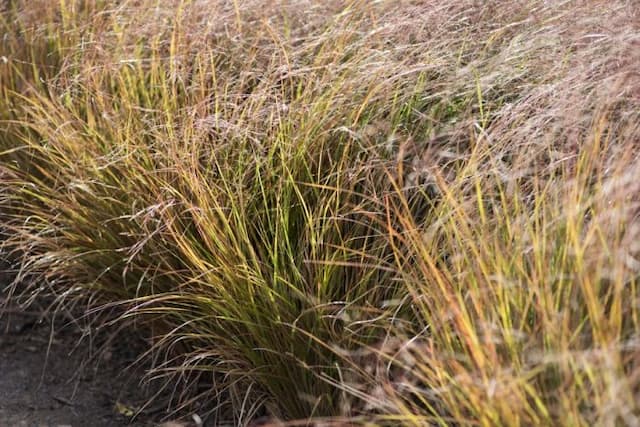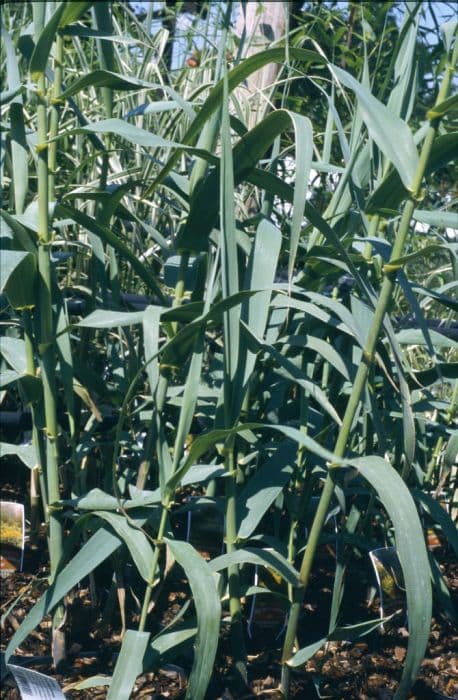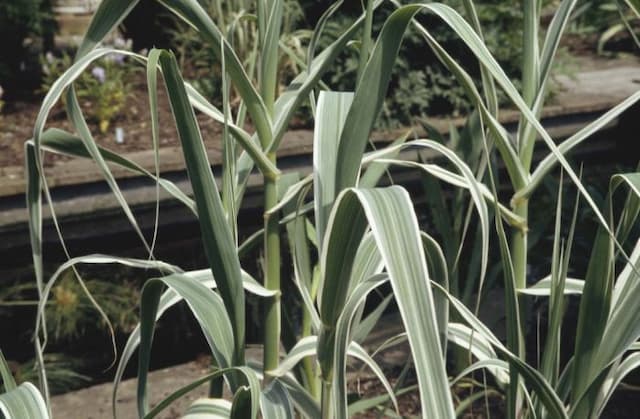Pampas Grass Cortaderia selloana 'Aureolineata' (v)

ABOUT
The plant commonly known as 'Aureolineata' is a variegated form of the Pampas Grass. It is distinguished primarily by its striking foliage and beautiful feathery plumes. The leaves of this ornamental grass display a unique coloration where the center is a creamy yellow that runs vertically along the blade, flanked by edges of a rich green hue. This variegation gives the leaves a vibrant, striped appearance that can add contrast and interest to a garden setting. In addition to its distinctive foliage, the Pampas Grass produces tall, arching flower plumes. These plumes are silky to the touch and emerge in a creamy white color, eventually maturing to a soft, beige tone. The feathery flowers stand out against the variegated leaves and can provide a sense of graceful movement when swayed by the breeze. The appearance of the plant can vary throughout the seasons, but its ornamental qualities remain a central focus for gardeners and landscapers seeking to add texture and color to their outdoor spaces. The combination of the striking variegated leaves and elegant flower plumes make 'Aureolineata' Pampas Grass a visually appealing addition to a garden.
About this plant
 Names
NamesFamily
Poaceae
Synonyms
Golden Pampas Grass, Yellow Pampas Grass, Variegated Pampas Grass
Common names
Cortaderia selloana 'Aureolineata'
 Toxicity
ToxicityTo humans
Pampas grass, the most common common name for Cortaderia selloana, is not generally known for being toxic if ingested. However, the sharp edges of the leaves can cause physical injury to the skin and eyes upon contact.
To pets
Pampas grass is not typically toxic to pets if ingested. However, like with humans, the sharp leaf blades can cause cuts or irritation to the mouth and digestive tract if a pet tries to eat them, and contact with the eyes can be particularly harmful due to the risk of injury from the plant's serrated edges.
 Characteristics
CharacteristicsLife cycle
Perennials
Foliage type
Evergreen
Color of leaves
Variegated
Height
6 feet (1.8 meters)
Spread
6 feet (1.8 meters)
Plant type
Grass
Hardiness zones
8
Native area
South America
Benefits
 General Benefits
General Benefits- Ornamental Value: The striped green and golden foliage of Cortaderia selloana 'Aureolineata', commonly known as Pampas Grass, offers a visually striking element to gardens and landscapes.
- Erosion Control: Pampas Grass has a robust root system that can help stabilize soil and prevent erosion on slopes or banks.
- Privacy Screen: With its tall growth habit, it can serve as an effective natural privacy barrier when planted in groups.
- Windbreak: The dense foliage and size of this plant make it suitable for protecting smaller plants from strong winds when positioned accordingly.
- Habitat for Wildlife: Pampas Grass can provide shelter and nesting sites for certain bird species and insects.
- Drought Tolerance: Once established, it is relatively drought-resistant, making it suitable for xeriscaping and water-wise gardens.
- Winter Interest: Even during the dormant winter months, the plumes provide longstanding texture and visual interest in the landscape.
- Low Maintenance: Pampas Grass typically requires minimal care once established, making it convenient for gardeners looking for low-effort plants.
- Versatility in Landscaping: It can be used in a variety of landscaping applications, including as a specimen plant, in mass plantings, or as part of mixed borders.
 Medical Properties
Medical PropertiesThis plant is not used for medical purposes.
 Air-purifying Qualities
Air-purifying QualitiesThis plant is not specifically known for air purifying qualities.
 Other Uses
Other Uses- Pampas grass can be used in craft projects, such as making dried flower arrangements or wreaths due to its long-lasting plumes.
- The tall and dense growth of Pampas grass can be planted as a privacy screen or a windbreak in landscaped gardens.
- This ornamental grass is sometimes used in soundproofing applications because its thick foliage can help dampen noise.
- It is also used as a habitat for wildlife; birds can use the dense foliage for shelter and the plumes for nest-building materials.
- Pampas grass is sometimes included in floral designs for events like weddings due to its aesthetic appeal and dramatic presence.
- Due to its height and structure, it can be used as a living sculpture or focal point in garden design and landscaping.
- The dried plumes of Pampas grass can be used for insulation in small structures like garden sheds because they can trap air.
- It can serve as a natural snow fence in colder regions, trapping snow and preventing drifts on roads and pathways.
- Pampas grass has been utilized in some regions as raw material for paper-making due to its fibrous nature.
- In coastal areas, it can help in stabilizing sand dunes by trapping sand with its extensive root system.
Interesting Facts
 Feng Shui
Feng ShuiThe Pampas grass is not used in Feng Shui practice.
 Zodiac Sign Compitability
Zodiac Sign CompitabilityThe Pampas grass is not used in astrology practice.
 Plant Symbolism
Plant Symbolism- Invincibility: As a tough and sturdy plant, Cortaderia selloana 'Aureolineata', commonly known as Pampas Grass, often symbolizes strength and endurance.
- Beauty and Softness: The feathery plumes of Pampas Grass can symbolize beauty and gentleness, representing an aesthetic appeal despite its ruggedness.
- Wealth and Abundance: The tall and abundant growth of Pampas Grass can signify prosperity and fullness, often used in landscape to create a sense of luxury.
- Privacy: Due to its dense growth habit, Pampas Grass can represent the need for privacy or secrecy, often planted to shield one's space from prying eyes.
 Water
WaterPampas Grass should be watered deeply about once a week, allowing it to soak up to 12-15 gallons of water each time during the growing season. In the winter months, reduce watering to every couple of weeks, depending on the climate and if there has been significant rainfall. It's important not to overwater, as Pampas Grass prefers a drier soil between waterings. Ensure the soil drains well to prevent root rot. For mature plants, watering can be less frequent as they are drought-tolerant, but newly planted grass will need consistent moisture to establish.
 Light
LightPampas Grass thrives in full sun conditions, meaning it requires at least 6 hours of direct sunlight daily. The best spot for Pampas Grass is in an open area where it can receive unfiltered sunlight throughout the day. While it can tolerate some light shade, too much shade can lead to poor growth and fewer plumes.
 Temperature
TemperaturePampas Grass prefers temperate climates and can survive in temperatures as low as 20°F and as high as 100°F. The ideal temperature range for optimal growth is between 70°F and 80°F. It's hardy and can survive winter chills, but prolonged exposure to temperatures below 20°F may damage the plant.
 Pruning
PruningPampas Grass should be pruned back in late winter or early spring before new growth begins to remove old foliage and make room for fresh shoots. Cut back to about a foot above ground level, doing so annually. Pruning not only maintains a tidy appearance but also encourages healthy, vigorous growth and allows for better air circulation within the plant.
 Cleaning
CleaningAs needed
 Soil
SoilPampas Grass prefers well-draining soil with a mixture of sand, loam, and peat for optimal growth, with a pH range of 6.0 to 7.5.
 Repotting
RepottingPampas Grass seldom needs repotting; it can be divided every few years in spring if it outgrows its space.
 Humidity & Misting
Humidity & MistingPampas Grass thrives best in moderate humidity levels, consistent with outdoor environments, as it is not typically a houseplant.
 Suitable locations
Suitable locationsIndoor
Grow in large containers, well-lit area, minimal care.
Outdoor
Full sun, well-drained soil, ample space to grow.
Hardiness zone
6-10 USDA
 Life cycle
Life cycleCortaderia selloana 'Aureolineata', commonly known as Pampas Grass 'Aureolineata', begins its life as a seed that germinates in warm, well-draining soil. Once sprouted, the seedling grows into a clump-forming perennial grass, developing long, narrow, arching green leaves with golden stripes. As the plant matures, it forms a dense tussock and in its second year, it produces tall, feathery plumes which can rise several feet above the foliage, usually blooming in late summer to fall. These plumes, which range from silvery white to pinkish tones, are dioecious, with separate male and female plants. Pampas Grass 'Aureolineata' is semi-evergreen and may retain some of its foliage throughout the winter, depending on the climate. After flowering, seeds are dispersed by wind, allowing the plant to spread and begin the cycle anew if conditions are favorable.
 Propogation
PropogationPropogation time
Spring-Summer
The most common method of propagation for Pampas Grass, which is the common name for Cortaderia selloana 'Aureolineata', is through division. This process is typically done in late winter or early spring before new growth begins. For successful division, the gardener would dig up the entire clump of the grass, ideally when the center of the clump starts to die out, indicating that it's a good time to rejuvenate the plant. The clump should then be separated into smaller sections, each with a portion of the roots intact, using a sharp spade or even a saw for larger, tougher specimens. These sections can then be replanted at the same soil level as they were previously growing, spaced approximately 6 to 8 feet (1.8 to 2.4 meters) apart to accommodate their large size at maturity. It's essential to water the new divisions thoroughly to help establish them in their new location.









